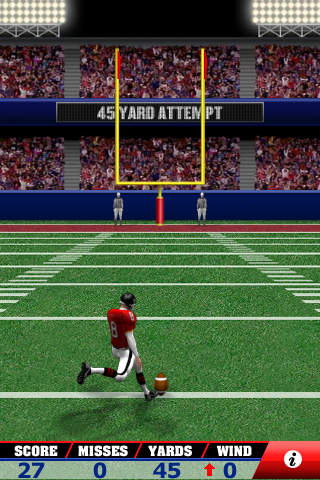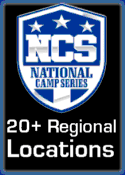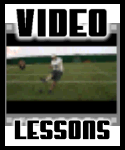|
GUEST EXPERT ARTICLE
Applying common sense and knowledge of universal movement, balance and problem solving and considering our Specialist are athletes not just kickers these days, it's time to look and consider the breakthrough of fundamental and mindset thinking. What I want to do here is discuss how we might apply the similar thinking of a golf swing to punting. Actually, distributing the most force or speed up and out and eliminating compensations. Our assumptions have been based on faliy. Time to change, let's keep it simple and remember, learning is ongoing. We're going to talk about creating desirable positions, eliminating common errors associated to punting and designing a plan with key coaching points you can reference. You might have to detach yourself from what you know briefly about punting but stay with me, I think you'll find that this makes sense and is something you will want to do. 1. Emphasize your set up for consistently better punts
Insight to Faster Times: By catching the ball away from the body will help your Get Off Ball Handling Times - Try to set it faster and punt with tempo. Try to keep the ball still as if it were on a "Table" and stationary object 4 yd. in front of your kicking foot - then be aggressive to that spot.
The main thing I teach is that punting, kicking or snapping for that matter is no different fundamentally then other sports like golf, baseball or track for example. On average players line up in a position to catch the punt as if they are anticipating a bad snap and just by the nature of their set up position are setting up the wrong things rather then triggering the first sequence of desired movement and position set up to punt. I ask players to consider keeping their feet apart but under their hips (So they can set straight vs having to step around their feet) keep their steps small enough that always have balance and the ability to make their next move without first recovering from the movement they just made and suggest they keep their knees together if they are having trouble walking straight (This will become an alignment issue if we don't).
Problem Solving: Players that have issues with being comfortable with their feet under their hips are typically distributing too much weight or lean to their forward foot and are most likely too worked up - thinking about generating force perhaps, prematurely as demonstrated by their foot work and body tension - Don't be "Godzilla"
Think a Step Ahead: Keep your weight distributed equally on both feet. Relax and focus on how you will be catching the ball, what position you want your arms to be immediately after you catch the snap and the tempo of the steps you will take forward. 2. Ball Set - Balance & Path are Important to the process
Many players are try punt the ball with their hips completely squared up or with no technique at all. Even though they are trying to kick the ball up and out because of the common errors of their approach and set up to punt they are instead actually kicking as they are still stepping as the approach and kick somehow seem to merge together. I teach players to get their knee in position to extend the lower leg or kick up and out.
The elbow determines where the hand is going inside or staying outside the hip (Desired). The key to a consistent ball set might just be locking the upper arm so it feels like you're wearing a cast and keep the ball still and level on your "Table".
Ball Set Factor : Most players' compromise their swing alignment and mishit punts because they are chasing the ball. This is typically caused from a ball set so high that wind will move it unless the conditions are perfect or from the early release of the ball where the ball will drop so fast that the kicking leg can't stay under it. Good players learn to read their ball flight, which is key for identifying problems.
Where to Hold the Ball : I ask players think of the catch and ball set sequence as a series of letting go where they immediately set the ball, let go with the opposite hand (left on a right footed punter) as the jab (first step) touches and the ball set hand releases flat without rolling the ball as the plant touches.
The first step taken forward straight vs outside the hip with the (Kicking Foot) is in a straight line with his hip and very small. He will hesitate so he can pick up his plant foot and set it down flat absent of "Push" where he is in the process to a more desirable position to kick.
When to Let Go: Most likely because we will be holding it longer and thus lessening our margin of error. If you were to measure your extended hand with ball to the extended foot you would notice that you only need to get the ball forward 3-12" inches usually. I ask players to hold the ball still just above the kicking side hip where their leg is just inside the inner panel, holding the ball until the plant feels like it's down and they can accelerate the knee and foot upward through the ball. This minimizes the ball movement mostly in part because once the plant foot balances the kicking leg should start creating speed upward much faster then having to wait for balance and position to re-establish where the likelihood of turning over balls increases dramatically.
3. Lock & Load - Position to Punt
By Completing the Approach Steps straight vs crossing - You'll create a position that compliments both lanes and speed. Think of it as the position and angle you will shoot your cannon off from.
Most players are saving punts because they're pushing through kicks off their drive or plant foot, they're moving forward as they are trying to kick the ball or swinging across and not straight up because of misaligned steps or they're most likely chasing the ball but mostly they are not applying the common sense of what they might already know. I ask players to set their feet and body in a position to be fast. If the ball for example, were a stationary object 4 yds. in front of their kicking side hip what tempo and position set up and leg action would kick the ball up and out at the greatest angle. In addition to offer the player a reference discipline, this leverage and friction principal seems to eliminate several destructive swing path, position and Force Displacement issues.
4. Friction - Mass on Mass - let your foot spend more time on the ball. By getting the kicking Leg Knee over the ball in alignment with the swing path the lower leg can extend upward in the desired direction. More time on the foot = More Transfer of Force into the Ball with "Foot Generated Speed".
Typically, players that no formal training just try to kick it as hard as they can and might actually hit a bomb now and then. I prefer to coach these types of players because they have no preconceptions of what correct punting is where most players who have been to camps have been told to "Leg Lock" at Impact where the kicking leg hyperextend, if you agree with Newton you will agree the knee must get above the ball where the lower leg can extend through impact firing the ball in the direction of the angle of extension. This is a classic case of speed displacement where the knee and leg angle to extend is forcing speed downfield vs upward and typically the secondary movers, the hip flexors in this case, combined with a push off the plant foot to get to the ball will take over the finish the swing. I ask players to think of the upward knee position as a "Trigger" anticipating the finish of kick "Extension" through impact upward.
Hint: Since the knee is going to move up so radically we will use the shoulders to maintain alignment so the swing and position doesn't unravel. The idea is that by pressing or thinking "Down" footwork and alignment positions will be desirable. Now since you're using the knee vs the upper leg you're more likely to have a true swing path upward through the ball. Newton likes that too.
5. Upswing Speed is king. Swing Straight up through it vs crossing over which is typically the result of of the steps and lanes being off.
Upswing Speed is key to distribution of force for maximum hang time, maximum distance. Notice that the swing lane is in line with the hip and upper body is creating space for the leg to upswing while the head forward helps balance. Also notice there is no push off the plant as we are emphasizing leg speed will with enough upswing torque pull you upward.
Most players with good intension try to kick the ball harder when they aren't getting the results they want. They typically become frustrated and let down but seldom do they ask for help and think it through? I looked at more then 1000 players in search of the elements of great performance. After measuring and evaluating foot speed and leg action I came to the conclusion that if we considered the swing in 3 phases - Down, Forward and Upward - the common denominator became upswing where ball impact happen between the knee and hips where the foot needed to be in the upward motion and significantly less above the hips.
Hint and Perspective: If you don't set up the knee and foot position to kick up and out, then you are probably kicking down or forward and being forced to comprise position and power. You'll usually notice that when it feels like you're chasing balls or pushing off your plant foot exploding as you kick up then you are probably using your body and hips rather then your leg to accelerate up and through impact.
6. Summary - reference Coach Points
The Breakthrough Ball Set promotes creating a stationary object - Attack that Spot.
By holding it longer, which eliminates errors and increases consistency. By establishing Body & Knee Position - we can increase success where the actual leg action is actually less then a 12" thus, promoting contact friction, more upward speed with swing path alignment.
So we discussed how punting is perhaps, like a golf swing, our balance and positions resemble a track and field high jump and to use our common sense and have a plan. Here are the key Coaching References and Definitions I establish and use on a daily basis with players. I also have hand signals for all these where you might catch and NFL or major college punter looking for me in the stands to give him a read and plan.
Catch & Set: If you set it immediately, you can be aggressive. You're creating a constant as if the ball were a stationary object 4 yds. in front of the kicking swing lane. Now you can go get it.
Walk Straight and Finish Approach: Keep your knees together and steps small and visualize what movement or position you will create at the end of the approach. This will discipline alignment, eliminate swing lane, timing issues and set up good punts.
Lock & Load : Create this position to punt. This is my most important point. Sometimes I just focus on having players do this because they will overcome other things if I just get them to this point. The players seem to like a walking rehearsal drill from start to "Lock and Load" because they tell me it promotes position awareness and common sense. Aim & Shoot High and Far!
Slingshot - Keep the Roof On: Just like a slingshot must be held still as it fires the rock through it, letting it become loose as it's firing will dramatically effect the leverage and aiming principals and likewise for punting. We achieve certain positions and maintain them so we can accelerate through impact on the upswing. I ask players to consider their head and shoulders as their rooftop - keep it over them, keep it level, keep it still and swing through the roof.
Perspective - Learning is Ongoing: Follow the footsteps of the top players. Question and conceptualize any information, in other words, make it "qualify". Most of the best players have a plan for every punt they visualize in their mind before it happens for real. Once you learn the fundamentals, the challenge becomes carrying the same visual or what we call "proprioceptive" focus - how it feels. Good players typically structure practice to simulate a game situations. The more the are successful at this the more they seem to be able to focus on their plan in the heat of game conditions.
Problem Solving
No Spirals - Ball is End over End or twisting up and across
The ball is twisting - Try to keep it flat with the nose turned inward slightly and down so the ball will deflect up and out. If the ball is turned upward you will usually connect the back of the ball which promotes the up and across (Good for Pooch Punting toward the Goal Line). If the ball has no distance you are most likely connecting the front of the ball where force is not being distributed up and out with the desired trajectory and distance needed.
Struggling for Consistency
Try to avoid moving the ball up and down. Walk Straight to a Spot you will make impact about 4 yds. in front of your kicking foot. Visualize this in your mind then do it for real. The idea again to try to create constants where the ball is still and your movement to the position (Approach) is consistent and aggressive.
Correct Leg Action Sequence
We do this with the Lower Leg slightly forward so it will move upward from low to high without having to move forward first and with a pointed toe downward or out so the Quad Extensors will be the primary movers where the leg will have difficulty with upper then lower leg sequence if the toe is up because the lack of antagonist in this leg action will usually result in a "Slide". We want 3rd Class Leverage : Think of the knee as a fulcrum that must stop so the leg can extend when it's time.
Mental Aspects of Visualization
You want to develop a routine and plan before practice and games that's consistent to your goals. Try to not make dramatic changes to what you're doing from one kick to the next but have a plan of focus for improvement on a daily basis - once you master one thing move to the next rather then randomly just focusing on this then that. Getting yourself on video can be perhaps, your best teacher but you will need to trial and error with a plan. Research your options for Coaching - Then call Pro College Football. Learn more about Paul Assad >>>
|

 Friction - Part of the Evolution in Punting
Friction - Part of the Evolution in Punting
 Doug and Tommy's Frequently Asked Questions
Doug and Tommy's Frequently Asked Questions




